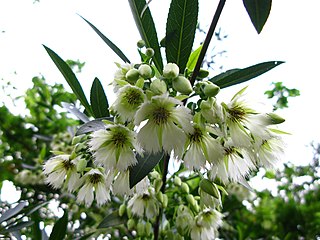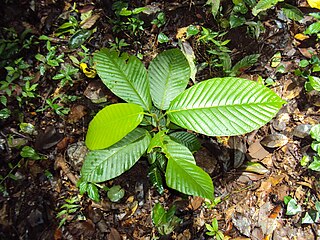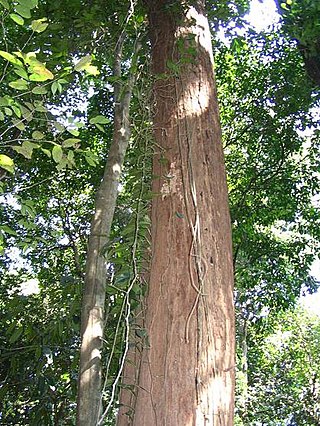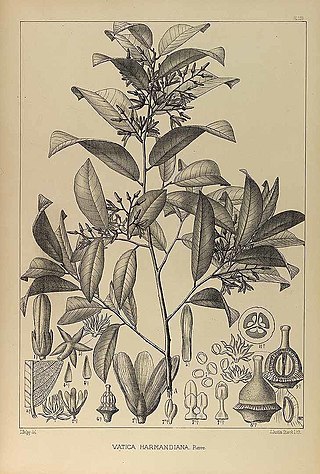
Elaeocarpus is a genus of nearly five hundred species of flowering plants in the family Elaeocarpaceae native to the Western Indian Ocean, Tropical and Subtropical Asia, and the Pacific. Plants in the genus Elaeocarpus are trees or shrubs with simple leaves, flowers with four or five petals usually, and usually blue fruit.

Dipterocarpus is a genus of flowering plants and the type genus of family Dipterocarpaceae.

Anisoptera costata is an endangered species of plant in the family Dipterocarpaceae. The specific epithet costata means "ribbed", referring to the prominent venation of the leaf blade. A huge emergent tree up to 65 m high, it is found in evergreen and semi-evergreen lowland tropical seasonal forests of Indo-Burma and in mixed dipterocarp forests of Malesia.

Hopea is a genus of plants in the family Dipterocarpaceae. It contains some 113 species, distributed from Sri Lanka and southern India to the Andaman Islands, Myanmar, southern China, and southward throughout Malesia to New Guinea. They are mainly main and subcanopy trees of lowland rainforest, but some species can become also emergent trees, such as Hopea nutans.

Anthoshorea bracteolata is a species of plant in the family Dipterocarpaceae. It is a tree native to Peninsular Malaysia, Peninsular Thailand, Singapore, Sumatra, and Borneo.
Richetia hopeifolia is a species of plant in the family Dipterocarpaceae. It is a tree native to Sumatra, Peninsular Malaysia, Borneo, and Mindanao in the Philippines.

Vatica is a genus of plants in the family Dipterocarpaceae. Its species range from India and southern China through Sri Lanka, Indochina, Indonesia, the Philippines, and New Guinea.

Vatica harmandiana, also known by the synonym Vatica cinerea, is a species of plant in the family Dipterocarpaceae. It is a smallish tree native to Southeast Asia. It is the most common plant species in certain types of mature woodland habitat within its range and is furthermore common in disturbed secondary forests covering much of its range, nonetheless it was considered, along with most Dipterocarpaceae, to be endangered by the IUCN between 1998 and 2017. It is usually not commercially harvested except for local use.
Vatica lowii is a species of plant in the family Dipterocarpaceae.
Vatica maingayi is a species of plant in the family Dipterocarpaceae. It is a tree found in Sumatra, Peninsular Malaysia, Singapore and Borneo. It is a Critically endangered species threatened by habitat loss.
Vatica nitens is a species of plant in the family Dipterocarpaceae. It is a tree native to Peninsular Thailand, Peninsular Malaysia, Sumatra, and Borneo. It is an endangered species threatened by habitat loss.

Anisoptera is a genus of plants in the family Dipterocarpaceae. It contains ten species distributed from Chittagong in southeast of Bangladesh to New Guinea.
Cotylelobium burckii is a species of plant in the family Dipterocarpaceae. The species is named after W. Burck, (1848–1910), a botanist that worked on the Dipterocarpaceae and the Sapotaceae. C. burckii is a canopy tree, up to 40 m, found in kerangas forests on deep white sand podsols. The species is endemic to Borneo. It is found in at least two protected areas.
Cotylelobium lanceolatum is a tree in the family Dipterocarpaceae. The specific epithet lanceolatum means "lance-like", referring to the shape of the leaf.
Dryobalanops oblongifolia is a species of plant in the family Dipterocarpaceae, native to regions of Southeast Asia and Maritime Southeast Asia.

Dipterocarpus condorensis is a species of plant in the evergreen or semi-evergreen family Dipterocarpaceae.

Urceola is a plant genus in the family Apocynaceae, first described as a genus in 1798. It is native to China, the Himalayas, Southeast Asia, and New Guinea.
Dipterocarpus lowii is a tree in the family Dipterocarpaceae.
Cotylelobium lewisianum is a species of tree in the Dipterocarpaceae family. It is critically endangered.

Richetia is a genus of flowering plants in the family Dipterocarpaceae. It includes 33 species of trees native to Peninsular Thailand, Peninsular Malaysia, Sumatra, Borneo, and the Philippines.











